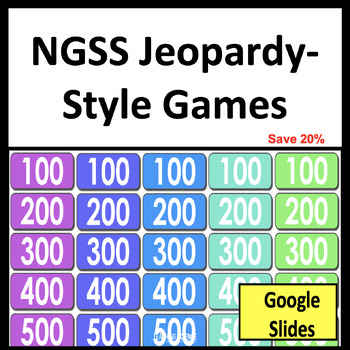Science Review Games Jeopardy Bundle for Middle School Science NGSS
Teaching Science With Lynda R Williams
5.6k Followers
Grade Levels
6th - 8th
Subjects
Resource Type
Standards
NGSSMS-LS1-5
NGSSMS-ESS1-4
NGSSMS-ESS2-3
NGSSMS-LS1-7
NGSSMS-ESS3-2
Formats Included
- Google Slides™
Pages
Over 800 Slides
Teaching Science With Lynda R Williams
5.6k Followers

Includes Google Apps™
This bundle contains one or more resources with Google apps (e.g. docs, slides, etc.).
What educators are saying
Worth every penny! I am sure I could make something similar...but this saved me so much time and effort....the questions are great, and my students love the Jeopardy games. Worth every penny!~
We used these games every Friday for our Friday Fun Review. The students look forward to this and it is a great way to review.
Products in this Bundle (15)
showing 1-5 of 15 products
Also included in
- This NGSS Middle School Science Bundle is my biggest bundle! It includes all my middle school science units, Bell Ringers, Jeopardy-style games, Assessments, and Informational Text Science Units for Middle School. It addresses all the NGSS standards for 6th, 7th, and 8th Grade NGSS science. Save whePrice $489.55Original Price $699.35Save $209.80
Description
Do you want to review science concepts in a fun and engaging way? This bundle includes all my Jeopardy-style science review games for middle school. Use them to review and prep your students for end-of-year science testing. They're easy to use and in Google Slides.
Each Jeopardy-style game has 25 questions. Each question is linked to a slide with the answer. The games can have up to five teams.
Jeopardy-style games Include:
- Editable Jeopardy-style game
- Answers
- Scorecard
- Instructions
Topics for the Bundle
Ecosystems
Energy
Engineering
Evolution
Force and Motion
Genetics
Human Impact
Matter and Chemistry
Molecules to Organisms
Solar System
Waves
Weather and Climate
Physical Science
Life Science
Earth and Space Science
Each Game takes about 45 minutes to play and require Google.
Total Pages
Over 800 Slides
Answer Key
Included
Teaching Duration
N/A
Report this resource to TPT
Reported resources will be reviewed by our team. Report this resource to let us know if this resource violates TPT’s content guidelines.
Standards
to see state-specific standards (only available in the US).
NGSSMS-LS1-5
Construct a scientific explanation based on evidence for how environmental and genetic factors influence the growth of organisms. Examples of local environmental conditions could include availability of food, light, space, and water. Examples of genetic factors could include large breed cattle and species of grass affecting growth of organisms. Examples of evidence could include drought decreasing plant growth, fertilizer increasing plant growth, different varieties of plant seeds growing at different rates in different conditions, and fish growing larger in large ponds than they do in small ponds. Assessment does not include genetic mechanisms, gene regulation, or biochemical processes.
NGSSMS-ESS1-4
Construct a scientific explanation based on evidence from rock strata for how the geologic time scale is used to organize Earth’s 4.6-billion-year-old history. Emphasis is on how analyses of rock formations and the fossils they contain are used to establish relative ages of major events in Earth’s history. Examples of Earth’s major events could range from being very recent (such as the last Ice Age or the earliest fossils of homo sapiens) to very old (such as the formation of Earth or the earliest evidence of life). Examples can include the formation of mountain chains and ocean basins, the evolution or extinction of particular living organisms, or significant volcanic eruptions. Assessment does not include recalling the names of specific periods or epochs and events within them.
NGSSMS-ESS2-3
Analyze and interpret data on the distribution of fossils and rocks, continental shapes, and seafloor structures to provide evidence of the past plate motions. Examples of data include similarities of rock and fossil types on different continents, the shapes of the continents (including continental shelves), and the locations of ocean structures (such as ridges, fracture zones, and trenches). Paleomagnetic anomalies in oceanic and continental crust are not assessed.
NGSSMS-LS1-7
Develop a model to describe how food is rearranged through chemical reactions forming new molecules that support growth and/or release energy as this matter moves through an organism. Emphasis is on describing that molecules are broken apart and put back together and that in this process, energy is released. Assessment does not include details of the chemical reactions for photosynthesis or respiration.
NGSSMS-ESS3-2
Analyze and interpret data on natural hazards to forecast future catastrophic events and inform the development of technologies to mitigate their effects. Emphasis is on how some natural hazards, such as volcanic eruptions and severe weather, are preceded by phenomena that allow for reliable predictions, but others, such as earthquakes, occur suddenly and with no notice, and thus are not yet predictable. Examples of natural hazards can be taken from interior processes (such as earthquakes and volcanic eruptions), surface processes (such as mass wasting and tsunamis), or severe weather events (such as hurricanes, tornadoes, and floods). Examples of data can include the locations, magnitudes, and frequencies of the natural hazards. Examples of technologies can be global (such as satellite systems to monitor hurricanes or forest fires) or local (such as building basements in tornado-prone regions or reservoirs to mitigate droughts).






